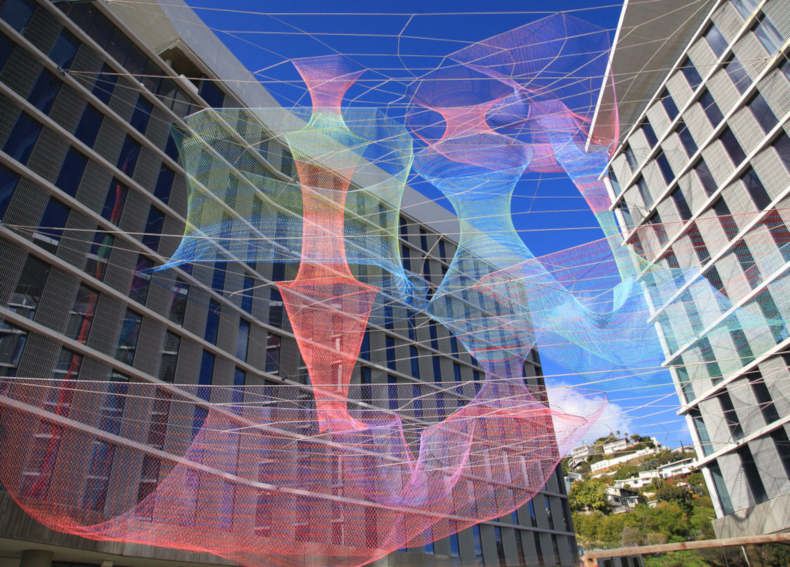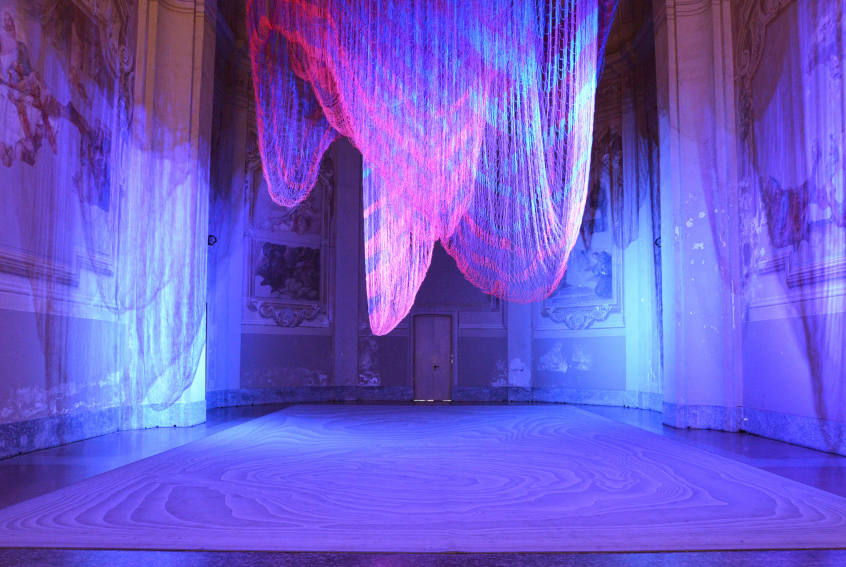
Janet Echelman’s Monumental Hanging Abstractions
A new, monumental, outdoor art installation recently premiered in the air space above The Peninsula Hotel in Hong Kong. Titled Earthtime 1.26 (Hong Kong), it is the newest work by Janet Echelman, a leader in the realm of contemporary public art. Suspended by cables from the architecture of the hotel, Earthtime 1.26 (Hong Kong) is a flexible fiber sculpture designed to fluctuate in response to shifts in wind, weather, daylight, and other atmospheric conditions. LED lights illuminate the fibers at night, creating the appearance of a ghostly, glowing, biomorphic mass hovering in the sky, like a massive, phosphorescent, urban jelly fish. The cryptic title of the work relates to an under-reported phenomenon that occurs when catastrophic events rock the planet. For example, most of us remember when an earthquake struck northeast Japan on 11 March 2011. That fateful day saw a tsunami hit the Japanese coast, and a nuclear disaster unfold at the Fukushima Daiichi nuclear plant. What most of us may not realize, however, is that the tectonic plate shift that caused that 8.9-magnitude earthquake shifted the mass of the planet to such a degree that it actually accelerated the rotation of the earth, causing the 24-hour day to decrease in duration by 1.8 micro-seconds. Echelman has adopted this phenomenon to guide the naming works in her Earthtime Series, which she started in order to address “the interconnectedness of nations.” Interconnectedness is embedded within every aspect of Earthtime 1.26 (Hong Kong). It literally demonstrates the principle of total collaboration within the public sphere. Not only does the title refer to interconnection, but the work responds to the movements of the earth, the wind, the sun, the moon and stars, and is physically connected to the infrastructure of the city itself. The work is so interconnected that it raises questions about where the art stops, and the realm of the imagination begins.
Discovering Fiber
Echelman did not start out as a fiber artist. She began her art career as a painter, but an unexpected inconvenience challenged her way of thinking, leading her on the path to where she is today. In 1997, after teaching at Harvard for five years, she received a Fulbright scholarship to lecture in India. She shipped her special painting supplies ahead of time, but when she arrived in India she realized that her painting supplies had been lost. Rather than scrambling for more painting supplies, she simply looked around at the local environment to see what she might be able to use to make her work. She became inspired by the nets the local fishermen were using. She adopted the nets to make what became her first fiber sculptures. After returning to the United States two years later, she began an ongoing process of refining that vision she initiated back in India on the beach. Her goal was to create living, responsive, ethereal artworks that collaborate with their surroundings in delicate, transformative, and situationally appropriate ways.

Janet Echelman- Earthtime 1.26 (Hong Kong), 2019. Fiber, Buildings and Sky combined with Colored Lighting. Fibers are braided with polyester and UHMWPE (Ultra high molecular weight polyethylene). Dimensions of net: 89’ length x 82’ width x 62’ height. Installation Dimensions: 157’ length x 109’ width x 130’ height. Location: The Peninsula Hong Kong, Salisbury Rd, Tsim Sha Tsui, Hong Kong. © Janet Echelman. Photography: Simon J Nicol, Nicki Houghton, Getty Images.
Echelman has since gone to great lengths to hone her idiosyncratic method. She has developed multiple individualized computer programs to aide in the design of her fiber sculptures. She has also adapted an industrial material used by NASA for the production of spacesuits to make a special twine to support her sculptures. She furthermore has embraced the idea that her sculptures should be neutral in terms of their effects on the natural environment. Since they are installed in the air space above public areas or around buildings, it is of great concern that birds or other animals might be caught up in the nets. Echelman has collaborated with scientists to ensure that her designs are open enough not to interfere with local bird populations. According to Echelman, or animal has ever been harmed by one of her sculptures.

Janet Echelman- Dream Catcher, West Hollywood, CA, 2017. Fiber, Buildings and Sky combined with Colored Lighting. Fibers are braided with UHMWPE (Ultra high molecular weight polyethylene) and PTFE (Polytetrafluoroethylene). Dimensions of net: 85 ft. height x 103 ft. width x 40 ft. depth. Installation dimensions: 100 ft. height x 110 ft. width. Location: 8490 Sunset Blvd, West Hollywood, CA 90069. © Janet Echelman. Photography: Daniel Zeese, Nicole Wang.
Scratching the Surface
Though she has become widely known as a fiber artist, Echelman has many other ideas about how her overarching ideas about space, light, and interconnectedness can be translated into different types of aesthetic phenomena. In 2018, she seized new ground (quite literally) with a permanent public art installation in Philadelphia called “Pulse.” The piece is embedded into the city street in historic Dilworth Park. Subway and trolley lines pass underneath the park throughout the day and night. Whenever a train passes beneath the work, special jets shoot water vapor into the air, which is then illuminated by projected lighting. The sprays of mist trace the path of the train cars, providing what Echelman calls “a living X-ray of the circulatory system of the city.” Passersby, meanwhile, are invited to play in the harmless mist, interacting with the artwork while also connecting their motions with the motions of the transportation system that brings people in and out of the city.

Janet Echelman- Possible futures of a line, traveling through space and time, Como, Italy, 2016. Custom-braided colored fiber, knotted into netting; injection-dyed carpet made from recycled netting; and LED colored lighting. Dimensions: variable, 18 ft. length x 18 ft. width x 16 ft. depth. Location: Church of San Francesco, Como, Italy. © Janet Echelman. Photography: Ilaria Provenzi.
By expanding her oeuvre into other types of aesthetic realms, Echelman is staying true to the guiding principle that has always informed her work: the importance of “taking imagination seriously.” In 2011, she delivered a TED Talk with that phrase as its title. It has since become one of the most popular TED Talks of all time, translated into 34 different languages and watched or listened to by millions of people around the world. The crux of what Echelman shares in the TED Talk revolves around not just the importance of imagination, but her recurring idea of the interconnectedness of nature, humans, and the built world. She talks about how her work connects the technologies of the ancient past with those of the future, since her nets, after all, are inspired by the ancient indigenous fishing nets of India, while her materials and processes include cutting edge technological advances of her own creation. By bringing every physical and experiential element together in the creation of the work, Echelman is raising our consciousness to the fact that every aspect of public space works together to create an aesthetic impression—a message that we are all truly one.
Featured image: Janet Echelman- Allegory, Eugene, Oregon, 2014. Braided polyester and colored lighting. 82 ft length x 34 ft. width x 30 ft. depth. Location: Matthew Knight Arena, University of Oregon, Eugene, OR, USA. © Janet Echelman. Photography: Ema Peter.
All images used for illustrative purposes only
By Phillip Barcio






